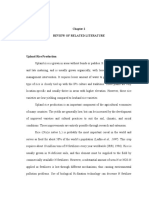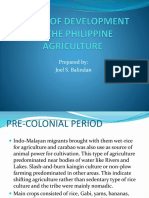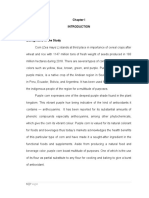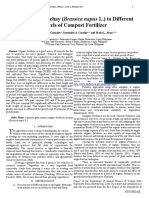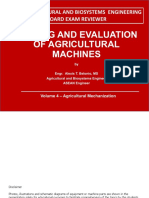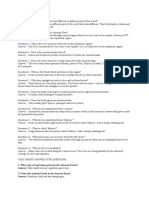Professional Documents
Culture Documents
Lesson 1 - Historical Background of Soil Fertility PDF
Lesson 1 - Historical Background of Soil Fertility PDF
Uploaded by
Rhea Joy FloraOriginal Description:
Original Title
Copyright
Available Formats
Share this document
Did you find this document useful?
Is this content inappropriate?
Report this DocumentCopyright:
Available Formats
Lesson 1 - Historical Background of Soil Fertility PDF
Lesson 1 - Historical Background of Soil Fertility PDF
Uploaded by
Rhea Joy FloraCopyright:
Available Formats
Republic of the Philippines
State Universities and Colleges
GUIMARAS STATE COLLEGE
Constancia, San Lorenzo, Guimaras
LESSON 1. HISTORICAL BACKGROUND OF SOIL FERTILITY
I. Introduction
Knowledge on the history is very important in all aspects of agriculture particularly in soil
fertility. It is very interesting to go back to where soil fertility has started, who are the persons
involved in the discovery, what and how are the activities performed, where those activities were
done, and when are those activities conducted. We are now enjoying the fruit of the discoveries of
those involved in generating knowledge on soil fertility. Because of them, the soil was valued and
the soil is viewed as an important resource for plant growth and development.
So, set back and relax as you let yourself dwell in the history of soil fertility. Enjoy the past
of soils!
II. Objectives:
After this lesson, you are expected to:
1. Familiarize the history of soil fertility.
2. Understand how the history started.
3. Identify the place, time, and people who started the understanding of soil
fertility.
III. Subject Matter:
References:
Banga, J. (2018). Soil fertility. Oakville, Ontario: Delve Publishing.
Food and Agriculture Organization of the United Nations. Nutrients and soil fertility management.
Retrieved from: http://www.fao.org/tc/exact/sustainable-agriculture-platform-pilot-
website/nutrients-and-soil-fertility-management/en/.
Gray, L. (2017). Soil science and management. New York, USA: Larsen and Keller Education.
Rana, SS., 2011. Compendium of Lectures (Theory cum practical): Principles and Practice of
Soil Fertility and Nutrient Management. Retrieved from:
http://www.hillagric.ac.in/edu/coa/agronomy/lect/agron-502/502-Soil-Fertility-and-
Nutrient-Management-SSR.pdf
Materials: Illustration, activity sheets, powerpoint presentations, movavi
Time allocation: 120 minutes
1 | SOIL FERTILITY CONSERVATION AND MANAGEMENT
Republic of the Philippines
State Universities and Colleges
GUIMARAS STATE COLLEGE
Constancia, San Lorenzo, Guimaras
IV. Procedure
1. ENGAGE
To start our subject on soil fertility, you need to learn the history of soil fertility in order
to understand how the knowledge on soil fertility came into being. This time, let us check if you
have prior knowledge of the topic. Answer the Pre-Test provide in the classroom through google
forms.
2. EXPLORE
Before dwelling in the history, I want to introduce to you the different photos of scientists
who made tremendous contribution in the history of soils. Familiarize their names and faces before
learning their contributions. Please see the PDF file named Scientist in the Soils History in the
classroom.
3. EXPLAIN
The history of the study of soil is intimately tied to our urgent need to provide food for
ourselves and forage for our animals. Throughout the history, civilizations have prospered or
declined as a function of the availability and productivity of their soils.
The Greek historian Xenophon (450-355 B. C.) is credited with being the first to expound
upon the merits of green-manuring crops: “But then whatever weeds are upon the ground, being
turned into earth, enrich soil as much as dung.”
Columella’s “Husbrandry”, circa 60 A.D., is credited the use of lime and that clover and
alfalfa (green manure) should be turned under, and was used by 15 generations (450 years) under
the Roman Empire until its collapse. From the fall of Rome to the French Revolution, knowledge
of soil and agriculture was passed on from parent to child and as a result, crop yields were low.
During the European Dark Ages, Yahga Ibn al-‘Awwam’s handbook, with its emphasis on
irrigation, guided the people of North African, Spain and the Middle East; a translation of this
work was finally carried to the southwest of the United States.
Experiments into what made plants grow first led to the idea that the ash left behind when
plant matter was burned was the essential element but the overlooked the role of nitrogen, which
is not left on the ground after combustion. In about 1635, the Flemish chemist Jan Baptist van
Helmont thought he had proved water to be essential element from his famous five years’
experiment with a willow tree grown with only the addition of water. His conclusion came from
the fact that the increase in the plant’s weight had apparently been only by the addition of water,
with no reduction in the soil’s weight. John Woodward (d. 1728) experimented with various types
of water ranging from clean to muddy and found muddy water the best, and so he concluded that
earthy matter was the essential element. Others concluded it was humus in the soil that passes
some essence of the growing plant. Still others held that the vital growth principal was
2 | SOIL FERTILITY CONSERVATION AND MANAGEMENT
Republic of the Philippines
State Universities and Colleges
GUIMARAS STATE COLLEGE
Constancia, San Lorenzo, Guimaras
something passed from dead plants or animals to the new plants. At the start of the 18 th century,
Jethro Tull demonstrated that it was beneficial to cultivate (stir) the soil, but his opinion that the
stirring made the fine parts of soil available for plant absorption was erroneous.
The French chemist Antoine Lavoisier showed about 1778 that plants and animals must
“combust” oxygen internally to live and was able to deduce that most of the 165-pound weight of
van Helmont’s willow tree derived from air. It the French agriculturists Jean-Baptiste Boussingault
who by means of experimentation obtained evidence showing that the main sources of carbon,
hydrogen and oxygen for plants were the air and water. Justus van Liebig in his book Organic
Chemistry in its Application to Agriculture and Physiology (published 1840), asserted that the
chemicals in plants must have come from the soil and air and that to maintain soil fertility, the
used minerals must be replaced. Liebig nevertheless believed the nitrogen was supplied from the
air. The enrichment of soil with guano by the Incas was rediscovered in 1802, by Alexander von
Humboldt. This led to its mining and that the Chilean nitrate and to its application to soil in the
United States and Europe after 1840.
The work of Liebig was a revolution for agriculture and so other investigators started
experimentation based on it. In England John Bennet Lawes and Joseph Henry Gilbert worked in
the Rothamsted Experimental Station, founded by the former, and discovered that plants took
nitrogen from the soil, and that the salts needed to be in an available state to be absorbed by plants.
Their investigations also produced the “superphosphate”, consisting in the acid treatment of
phosphate rock. This led to the invention and use of potassium (K) and nitrogen (N) as fertilizers.
Ammonia generated by the production of coke was recovered and used as fertilizer. Finally, the
chemical basis of nutrients delivered to the soil in manure was understood and in the middle 19 th
century chemical fertilizers were applied. However, the dynamic interaction of soil and its life
forms awaited discovery.
In 1856 J. T. Way discovered that ammonia contained in fertilizers was transformed into
nitrates, and twenty years later R.W. Warington proved that this transformation was done by living
organisms. In 1890 Sergei Winogradsky announced he had found the bacteria responsible for this
transformation.
It was known that certain legumes could take up nitrogen from the air and fix it to the soil
but it took the development of bacteriology towards the end of the 19 th century to lead to an
understanding of the role played in nitrogen fixation by bacteria. The symbiosis of bacteria and
leguminous roots and the fixation of nitrogen by bacteria, were simultaneously discovered by
German agronomist Hermann Hellriegel and Dutch microbiologist Martinus Beijerinck.
Crop rotation, mechanization, chemical and natural fertilizers led to a doubling of wheat
yields in Western Europe between 1800 and 1900.
3 | SOIL FERTILITY CONSERVATION AND MANAGEMENT
Republic of the Philippines
State Universities and Colleges
GUIMARAS STATE COLLEGE
Constancia, San Lorenzo, Guimaras
4. ELABORATE
You now became familiar with the different scientists who have contributed so much
wisdom in the science of soil fertility. This time, select one scientist from among the scientists in
the history of soils. Go to the Learning Activity section under Lesson 1 in google classroom and
check the desktop research activity that you have to conduct entitled, “Biography of Scientist in
the History of Soils”.
5. EVALUATION
Congratulations! You are done with Lesson No. 1. On the link provided in this classroom,
answer the assessment questions based on your learning on the history on soil fertility. Click
Lesson 1_Assessment in the classroom to go to the link.
4 | SOIL FERTILITY CONSERVATION AND MANAGEMENT
You might also like
- John Deere Service Repair Manual PDF DownloadDocument7 pagesJohn Deere Service Repair Manual PDF DownloadLeonardo Romero Jimenez20% (5)
- Pechay Production GuideDocument23 pagesPechay Production GuideMajorineNoch keine Bewertungen
- Crop SciDocument86 pagesCrop SciAnalYn Litawan Bucasan100% (1)
- Growth and Yield of Radish (As Affected by Different Concentrations of Fish Amino AcidDocument28 pagesGrowth and Yield of Radish (As Affected by Different Concentrations of Fish Amino AcidPrincess Jhobie Celin DivinagraciaNoch keine Bewertungen
- Principles of Crop ProductionDocument18 pagesPrinciples of Crop ProductionLenny Fe Repe Largo100% (1)
- Minus One Element Technique 1Document16 pagesMinus One Element Technique 1Maria Ric50% (2)
- Chapter 2-REVIEW OF RELATED LITERATUREDocument18 pagesChapter 2-REVIEW OF RELATED LITERATUREMaria Lovella Misolas Diaz100% (1)
- Origin Domestication and History of Some Important CropsDocument3 pagesOrigin Domestication and History of Some Important CropsTerence Cerbolles Serrano71% (7)
- Stages of Development of The Philippine Agriculture 1Document11 pagesStages of Development of The Philippine Agriculture 1Franzis Pobocan Del Socorro50% (2)
- Ajor Crops of The Regions of The HilippinesDocument25 pagesAjor Crops of The Regions of The HilippinesAbbie Ugot100% (1)
- Imo TomatoDocument42 pagesImo TomatoChristian Palma100% (1)
- Review of Related Literature and StudiesDocument7 pagesReview of Related Literature and Studiesjirppy Esparaguera0% (1)
- Successful FPJDocument15 pagesSuccessful FPJJessa Marie Nagar Calunod100% (3)
- MARTIN H. BUTAC Narrative Report (MOET)Document12 pagesMARTIN H. BUTAC Narrative Report (MOET)Rovieda ButacNoch keine Bewertungen
- Physiological Response of Glutinous Corn To Rates of Fermented SeaweedDocument20 pagesPhysiological Response of Glutinous Corn To Rates of Fermented SeaweedMark Iandy Lumamig100% (1)
- LAB EXER 1 (Crop Scie Lab)Document7 pagesLAB EXER 1 (Crop Scie Lab)Zyra Macasling100% (3)
- Site Characterization and SelectionDocument29 pagesSite Characterization and Selectionsamuel pineda100% (1)
- Jessac RepublicaDocument21 pagesJessac Republicajessa republicaNoch keine Bewertungen
- CHAPTER 1 IntroductionDocument4 pagesCHAPTER 1 IntroductionMARK DEVEN LEAL100% (3)
- Growth and Yield of Okra 2nd DraftDocument17 pagesGrowth and Yield of Okra 2nd DraftSaheden SalilawanNoch keine Bewertungen
- MOET TechnologiesDocument10 pagesMOET TechnologiesPhilRice Field Office CMUNoch keine Bewertungen
- Module Introduction To Water Management and IrrigationDocument11 pagesModule Introduction To Water Management and IrrigationShiela Marie Gatchalian100% (2)
- Group 6:: Specialized Production SystemsDocument15 pagesGroup 6:: Specialized Production SystemsRalfDa Real Flores CampoidNoch keine Bewertungen
- Performance of Zucchini Applied With Fish Amino Acid ConcoctionDocument50 pagesPerformance of Zucchini Applied With Fish Amino Acid ConcoctionVon Carlo Tabuan Lpt100% (1)
- HortiDocument7 pagesHortiSunday Glo M. Cabuyao100% (4)
- Practicum Narrative ReportDocument39 pagesPracticum Narrative ReportMarco AglibotNoch keine Bewertungen
- Thesis Proposal (04-10-22)Document32 pagesThesis Proposal (04-10-22)laila dennis jabalNoch keine Bewertungen
- MOETDocument9 pagesMOETRia Mae Espenida GurayNoch keine Bewertungen
- Growth and Yield Performance of Radish (Raphanus Sativus L.) Under Basal and Foliar Fertilizer ApplicationDocument21 pagesGrowth and Yield Performance of Radish (Raphanus Sativus L.) Under Basal and Foliar Fertilizer ApplicationJanmark Ahig80% (5)
- Phaseolus Vulgaris) : "String Bean (L. Performance Apply With Different Animal Manure: Effects On Growth and Yield''Document17 pagesPhaseolus Vulgaris) : "String Bean (L. Performance Apply With Different Animal Manure: Effects On Growth and Yield''Jericho Basmayor SajulanNoch keine Bewertungen
- This Study Resource Was: Module 1: Introduction To Basic Farm Machineries and Mechanization I. ObjectivesDocument3 pagesThis Study Resource Was: Module 1: Introduction To Basic Farm Machineries and Mechanization I. ObjectivesKRIZZAPEARL VER100% (5)
- Effect of FAA (Fish Amino Acid) Powder To The Growth Performance of Cucumber (Cucumis Sativus)Document3 pagesEffect of FAA (Fish Amino Acid) Powder To The Growth Performance of Cucumber (Cucumis Sativus)Melody DacanayNoch keine Bewertungen
- Use of Different Soil Media in Asexual Propagation (Marcotting) of Papaya (Carica Papaya)Document15 pagesUse of Different Soil Media in Asexual Propagation (Marcotting) of Papaya (Carica Papaya)Jevelyn Mendoza FarroNoch keine Bewertungen
- 2.history of ExtensionDocument22 pages2.history of ExtensionNico Rey Yamas RANoch keine Bewertungen
- Edited Bell PepperDocument9 pagesEdited Bell PepperSubic AutoNoch keine Bewertungen
- FAQ On MOETDocument2 pagesFAQ On MOETdelacruzjoby100% (1)
- PechayDocument1 pagePechayLugabaluga60% (5)
- The Problem and Its Background: Apayao State CollegeDocument44 pagesThe Problem and Its Background: Apayao State CollegeBrille Adrian FernandoNoch keine Bewertungen
- PURPLE CORN FLOUR STA MARIA THESIS OUTLINE Final Revised2Document43 pagesPURPLE CORN FLOUR STA MARIA THESIS OUTLINE Final Revised2Jain EpifanioNoch keine Bewertungen
- Narrative ReportDocument1 pageNarrative ReportMariquel FurioNoch keine Bewertungen
- Exte Sion in The Philippine SettingDocument41 pagesExte Sion in The Philippine SettingVanshence neosilver100% (2)
- EinführungDocument9 pagesEinführungDianne Laurice Magnaye RodisNoch keine Bewertungen
- Final ManuscriptDocument59 pagesFinal ManuscriptNikki Charm Aguilar DeronioNoch keine Bewertungen
- Review of LiteratureDocument14 pagesReview of LiteratureMateen Sajid50% (2)
- Research Not FinalDocument34 pagesResearch Not FinalinspiracionsinfuegoNoch keine Bewertungen
- 2 - AGR 32 Land Preparation - UplandDocument12 pages2 - AGR 32 Land Preparation - UplandAngelo HernandezNoch keine Bewertungen
- CPT 31Document7 pagesCPT 31Precious Collantes Quarteroz100% (1)
- Abm 103 - 8. Marketing SubsystemDocument63 pagesAbm 103 - 8. Marketing SubsystemJene Michelle Macalagay100% (3)
- PechayDocument4 pagesPechaySannie Ong Monoy100% (1)
- Production Performance of Native ChickenDocument6 pagesProduction Performance of Native ChickenAileen BaldecasaNoch keine Bewertungen
- Thesis OutlineDocument13 pagesThesis OutlineAileen Elegado100% (2)
- Lab Activity Propagation of Selected Tropical Fruits and Plantation Crops1Document11 pagesLab Activity Propagation of Selected Tropical Fruits and Plantation Crops1Jevelyn Mendoza Farro100% (1)
- Effects of Vermicast and Inorganic Fertilizer On The Yield of Spring OnionDocument8 pagesEffects of Vermicast and Inorganic Fertilizer On The Yield of Spring OnionAlverastine An100% (2)
- Growing Pechay (Brassica Napus L.) in Different Organic MulchesDocument4 pagesGrowing Pechay (Brassica Napus L.) in Different Organic MulchesAdizHares100% (1)
- GROWTH AND YIELD OF OKRA 2nd DraftDocument14 pagesGROWTH AND YIELD OF OKRA 2nd DraftSaheden Apo SalilawanNoch keine Bewertungen
- Response of Finger PepperDocument8 pagesResponse of Finger PepperRodolfo Ofiana Jr.67% (3)
- Baby Thesis7Document38 pagesBaby Thesis7jay ar canieteNoch keine Bewertungen
- Republic of The Philippines Western Mindanao State University College of Agriculture Agricultural Sciences Department San Ramon, Zamboanga CityDocument112 pagesRepublic of The Philippines Western Mindanao State University College of Agriculture Agricultural Sciences Department San Ramon, Zamboanga CityJaryll Vhasti P LagumbayNoch keine Bewertungen
- History of Soil Science AcceptedDocument12 pagesHistory of Soil Science Acceptednyeboe70100% (1)
- 1 Soil Science 2 Lecture HandoutsDocument10 pages1 Soil Science 2 Lecture HandoutsJomar SalemNoch keine Bewertungen
- Afa Group2 Reflection 13Document3 pagesAfa Group2 Reflection 13louella repolloNoch keine Bewertungen
- Role of Nano Fertilizers in Agricultural Farming 1Document3 pagesRole of Nano Fertilizers in Agricultural Farming 1Fitri SukmawatiNoch keine Bewertungen
- DuPont Pastora LabelDocument14 pagesDuPont Pastora Labeldsl64Noch keine Bewertungen
- Rice Tariffication LawDocument2 pagesRice Tariffication LawDane Delina0% (1)
- 5-Amanullah Et Al-2007-Poultry Manure To Crops-ReviewDocument7 pages5-Amanullah Et Al-2007-Poultry Manure To Crops-ReviewNaztovenNoch keine Bewertungen
- Practical Research 1, GROUP 5. CHASTITYDocument18 pagesPractical Research 1, GROUP 5. CHASTITYSarmiento, Raphael M.Noch keine Bewertungen
- Production Increases in Meat and Dairy Goats by Technology and Infrastructure Improvements For Asian Small-Scale FarmersDocument3 pagesProduction Increases in Meat and Dairy Goats by Technology and Infrastructure Improvements For Asian Small-Scale FarmersRa ElleNoch keine Bewertungen
- How To Practice IPMDocument2 pagesHow To Practice IPMMary Joy Lucob TangbawanNoch keine Bewertungen
- Manjericao SalinidadeDocument10 pagesManjericao Salinidaderecutamento livreNoch keine Bewertungen
- Determination of Frying Temperature and Vacuum PressureDocument5 pagesDetermination of Frying Temperature and Vacuum PressureBosco BeloNoch keine Bewertungen
- Aberdeen Angus Management Guide May 2012Document9 pagesAberdeen Angus Management Guide May 2012carlosNoch keine Bewertungen
- Ethiopia-Food Security Outlook-June 2022-FinalDocument19 pagesEthiopia-Food Security Outlook-June 2022-FinalElijah IbsaNoch keine Bewertungen
- Ibps AfoDocument15 pagesIbps Afotaitea4Noch keine Bewertungen
- 2023-DTAM-Chap13 - Testing and EvaluationDocument41 pages2023-DTAM-Chap13 - Testing and EvaluationErika HonorioNoch keine Bewertungen
- Screenshot 2023-03-18 at 12.58.00 PM PDFDocument45 pagesScreenshot 2023-03-18 at 12.58.00 PM PDFsisterspookthNoch keine Bewertungen
- Core Code of Conduct: For Individual and Multi-Site CertificationDocument38 pagesCore Code of Conduct: For Individual and Multi-Site CertificationDeshandra Afga NagaraNoch keine Bewertungen
- BerichtDocument4 pagesBerichttopseasontrdNoch keine Bewertungen
- ICT For Agricultural Management Session 3 & 4 Aug 8, 2022Document49 pagesICT For Agricultural Management Session 3 & 4 Aug 8, 2022Sangram AsabeNoch keine Bewertungen
- Jackfruit Value Addition ArticleDocument3 pagesJackfruit Value Addition ArticleBaliboola.N.ivanNoch keine Bewertungen
- Microcontroller Based Drip Irrigation System: D.Kotaiah Swamy, G.Rajesh, M.Jaya Krishna Pooja, A.Rama KrishnaDocument4 pagesMicrocontroller Based Drip Irrigation System: D.Kotaiah Swamy, G.Rajesh, M.Jaya Krishna Pooja, A.Rama KrishnaDershana LachmanNoch keine Bewertungen
- PPMC Warehouse Actual Count of Cases (06.23.2023)Document10 pagesPPMC Warehouse Actual Count of Cases (06.23.2023)Alyssa Mae GuroNoch keine Bewertungen
- TleDocument7 pagesTleHeart GonzalesNoch keine Bewertungen
- Human Environment Interactions (The Tropical and The Subtropical Region)Document5 pagesHuman Environment Interactions (The Tropical and The Subtropical Region)suvashreeNoch keine Bewertungen
- Bhalchandra JagtapDocument10 pagesBhalchandra Jagtaprahul dantkaleNoch keine Bewertungen
- 06 - Chapter 1Document14 pages06 - Chapter 1Mohsin SumanNoch keine Bewertungen
- Social Science Class 10 Important Questions Geography Chapter 4 Agriculture - Learn CBSEDocument15 pagesSocial Science Class 10 Important Questions Geography Chapter 4 Agriculture - Learn CBSESHARANYA SAHANoch keine Bewertungen
- Performance of Phosphorus and Sulphur On The Growth and Yield of Sunflower (Helianthus Annus L.)Document7 pagesPerformance of Phosphorus and Sulphur On The Growth and Yield of Sunflower (Helianthus Annus L.)Dr. Satish Singh BaghelNoch keine Bewertungen
- Privilege Speech of Hon. Rex Sarabia, Member of The Sangguniang Panlungsod NG Iloilo Delivered On June 7, 2023 During The Regular Session of The Sangguniang Panlungsod NG IloiloDocument4 pagesPrivilege Speech of Hon. Rex Sarabia, Member of The Sangguniang Panlungsod NG Iloilo Delivered On June 7, 2023 During The Regular Session of The Sangguniang Panlungsod NG IloiloSelurongNoch keine Bewertungen
- A. Identification of Location Province: City: Barangay: Purok: Household Identification Number: Household Address: B. DemographyDocument3 pagesA. Identification of Location Province: City: Barangay: Purok: Household Identification Number: Household Address: B. Demographymark gempisawNoch keine Bewertungen






